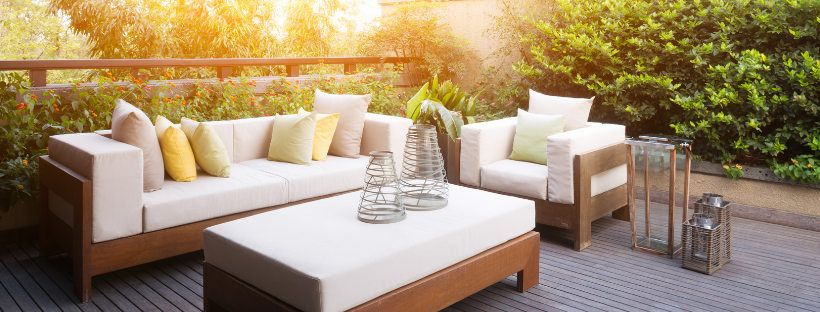A guide to caring for your outdoor furniture
Author: John Smith Date Posted: 8 May 2019


Spending time outdoors helps enhance your mental and physical well-being. However, rusty and dirty furniture could compromise this experience. Although it seems to be a minor inconvenience, dirt and rust could damage the structure of your outdoor fittings in the long run. Taking care of your outdoor furniture is very different from caring for a home’s interior. That is why a proper procedure and guide is extremely necessary when it comes to maintaining them.
Caring for wood
A diverse range of wood is used for furniture finishings given that it is one of the most beautiful materials for an outdoor setting. Wood tends to weather naturally over time, enhancing its rugged character. Nevertheless, it is still important to treat them to prevent decay.
After removing the dust off the wood with a damp cloth, you can apply a gentle cleanser to deeply clean the wood. Oil-based soaps are ideal for wood given that, most often, they are free of harsh chemicals and easy to use. If your wooden furniture develops mould during cold and wet months, allow it to dry off before cleaning. Thereafter, scrub the surface with a dry brush until the mould flakes off. After this, you must allow it to fully dry before further cleaning.
During spring and summer seasons when you are bound to be outdoors, make sure to wipe the wood at least once a week with a damp cloth to prevent dust from gathering and impacting the appearance of the furniture.
It is also important to check with your furniture manufacturer on the most appropriate product for your furniture as well as ask for instructions on how best to apply it. A hardware check once a year is also encouraged to ensure the longevity of your furniture.
Caring for metal
Metal outdoor furniture ranging from wrought iron, aluminium and steel is known for its low maintenance. It adds a sense of class to any setting and is adored for its durability. However, the biggest risk to metal is oxidisation over time. The good news is that controlling oxidisation is quite easy. Waterproof covers, brushing off the rust with a homemade mix of vinegar and water are simple yet proven methods.
Most aluminium fittings are finished with a powder coating that resists damage. However, if you reside in the coastal area, monthly washes are encouraged so as not to allow the salt to remain on the metal.
Remove rust on metal by using fine grit sandpaper. After the rust is completely cleaned, use a rust-resistant metal paint to touch up - then let it dry. Finally, apply car wax to protect the area. As with wood, when it comes to metal furniture, check with your manufacturer for any brand-specific instructions.
Caring for plastic and wicker
Plastic and wicker furniture is a favourite amongst many given that it’s season friendly for any climate. Similar to metal, plastic and wicker are also low-maintenance. Its cleaning process is extremely simple. All you’ve got to do is dust and use a cleaner that is chlorine and bleach-free. A gentle cleanser free of any abrasive particles is ideal for these materials. Keep in mind that corrosive ingredients deteriorate and harm plastic furniture. To give your furniture a shiny finish, you can rub it with car wax. It also acts as an extra layer of protection.
Key takeaways on caring for your outdoor furniture.
After a few seasons, your outdoor furniture is bound to deteriorate, especially because the outdoors is prone to many natural threats. Heavy rains and the scorching heat affects the longevity of your furniture, while the incorrect manner of maintenance worsens its durability. That is why it is extremely important to be aware of the specific requirements needed for each material. Make sure to discuss the best methods of caring for your furniture with brand manufacturers themselves.
Shop with us at Exclusive Trading Group to get your hands on a variety of outdoor furniture that is truly one of a kind. Thanks to Afterpay, ZipPay and ZipMoney, you can purchase your items instantly and pay in instalments.





